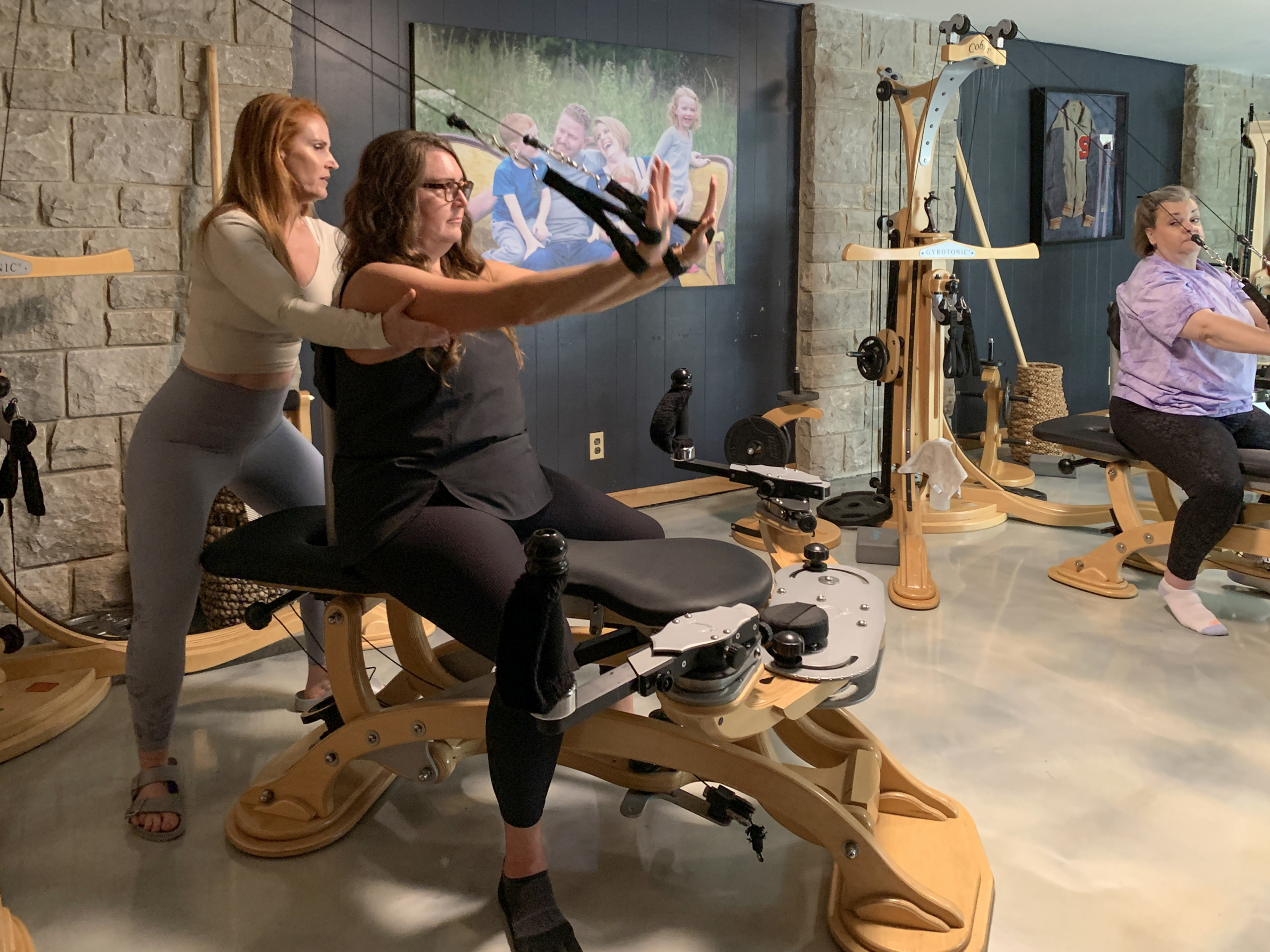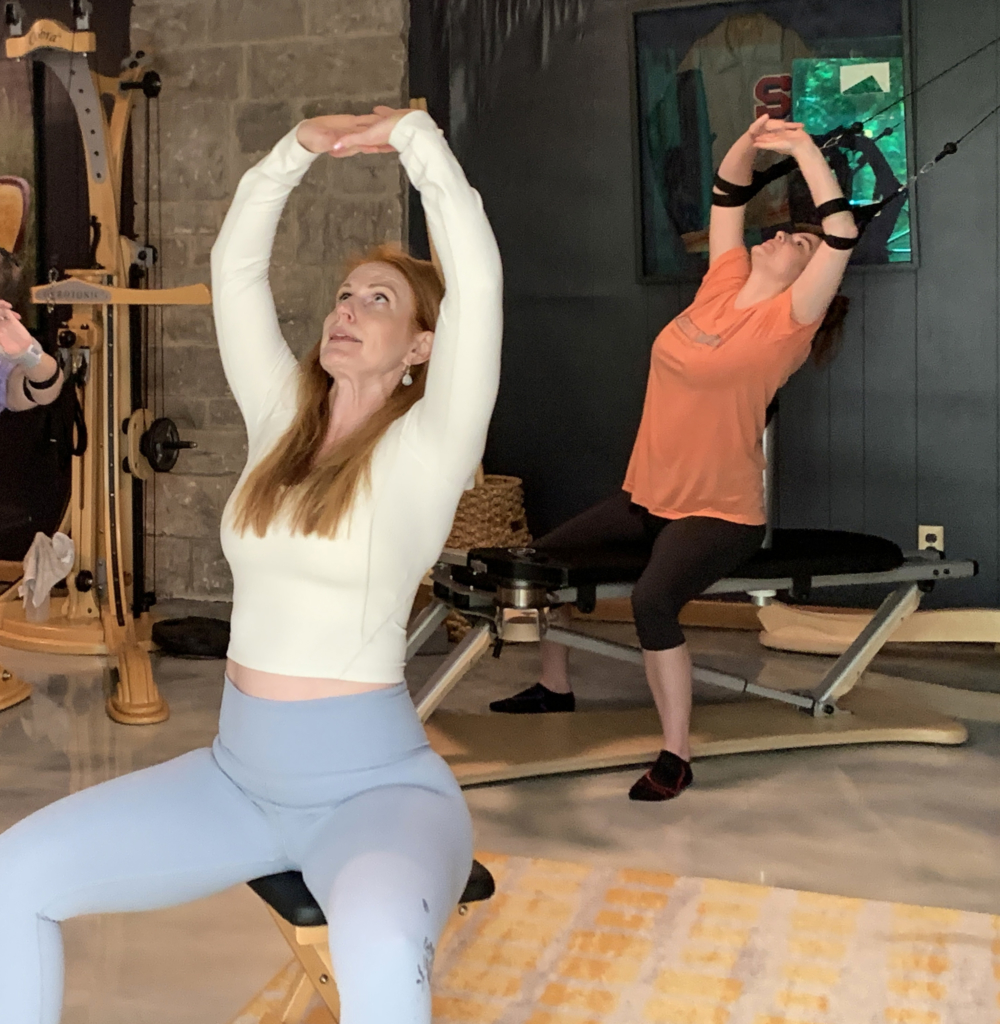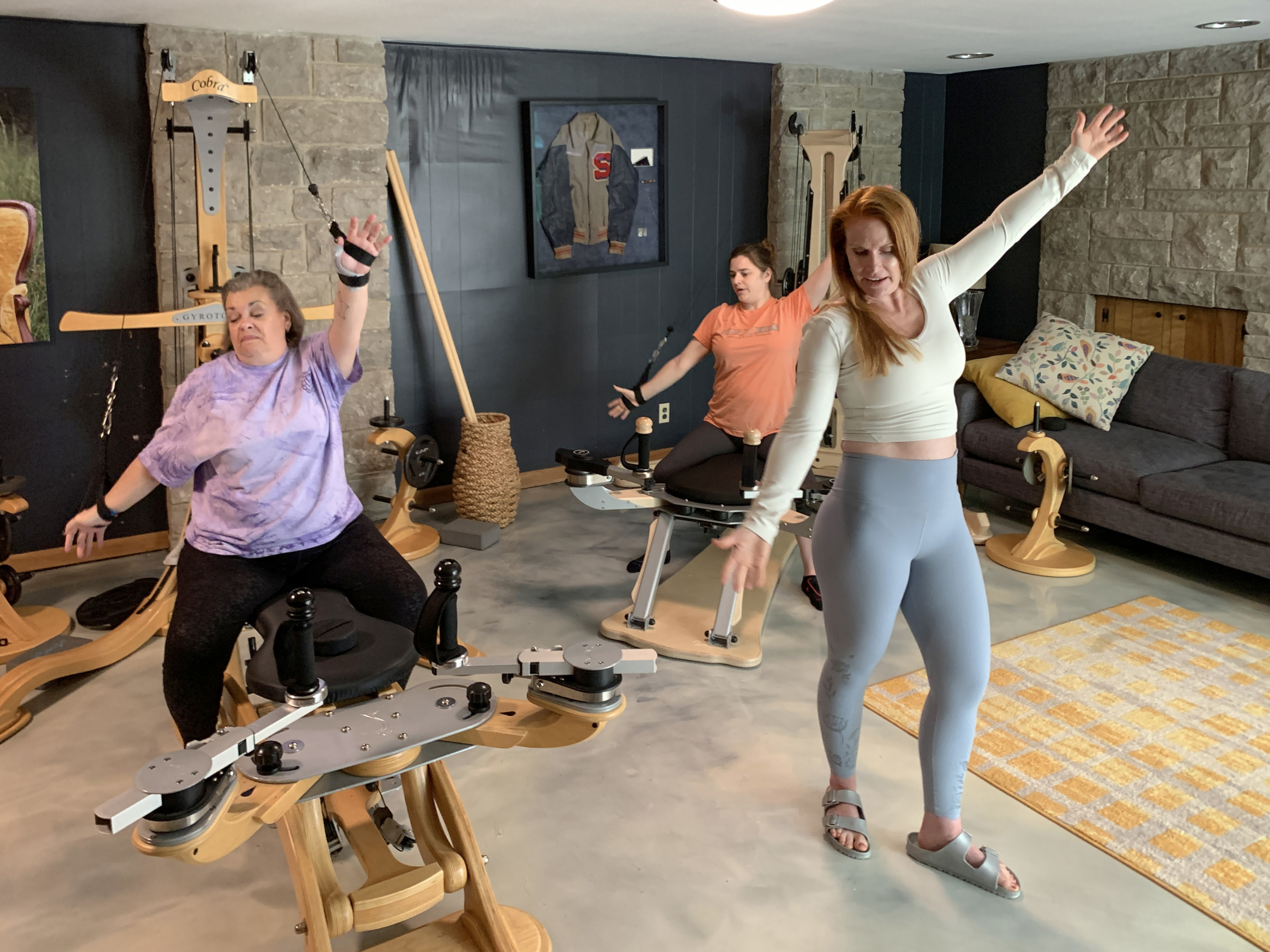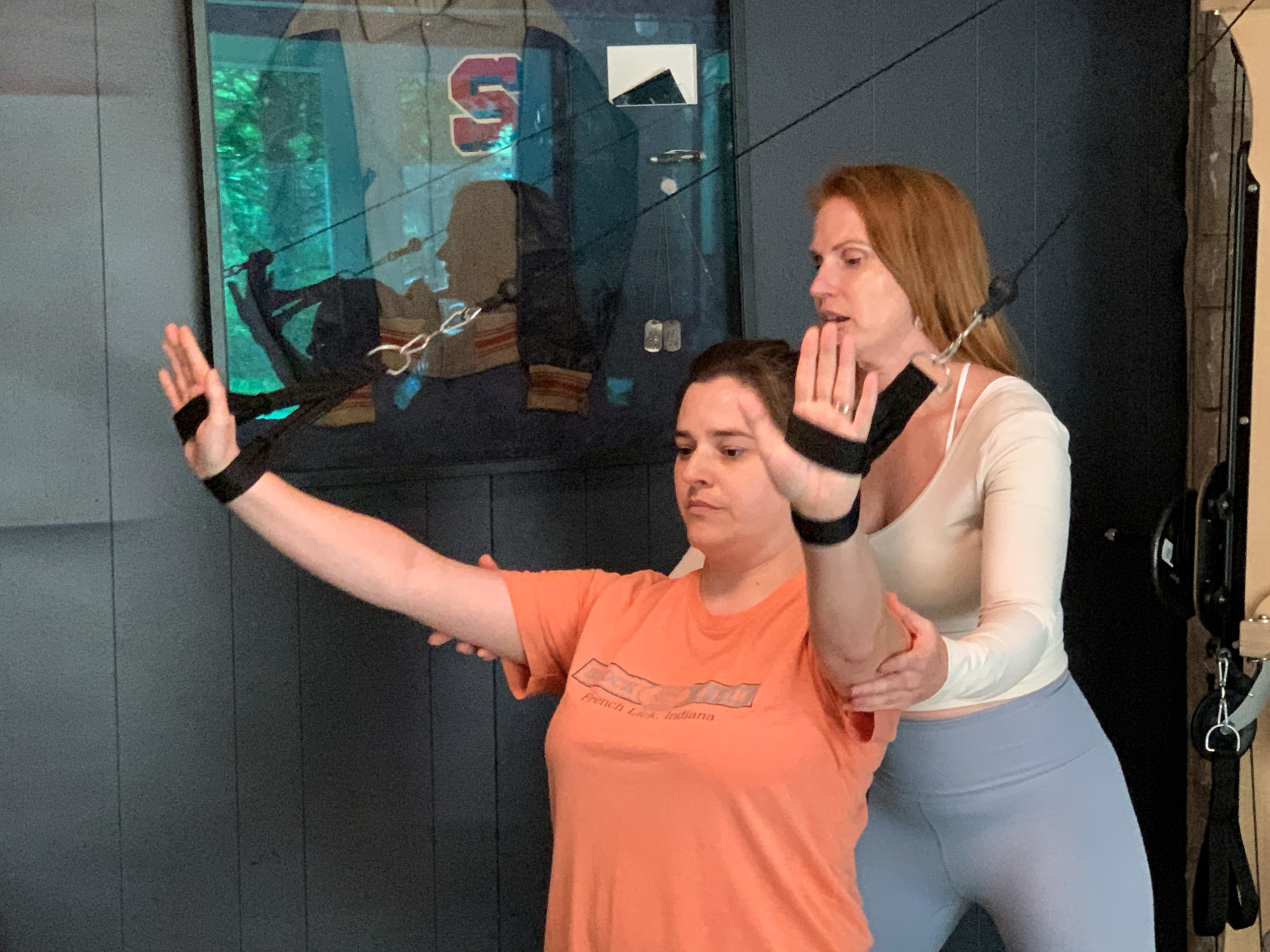Movement Professional Finds Fresh Inspiration in GYROTONIC® Education
Blog Content Interviews Testimonial // September 13, 2022
GYROTONIC® Trainer Chandler Moore Sanders, has always been a lover of movement. Cina Canada, Gyrotonic Headquarters Media Coordinator, sat down for a conversation with Chandler about her journey as a movement professional. In this interview, she shares about how she discovered the GYROTONIC® and GYROKINESIS® Methods and how this system expanded her teaching repertoire.
You can also listen to this interview through the recording below.
Cina: Thank you so much for speaking with me today Chandler. I know you have taught various types of movement over the years. Can you tell me a little bit about your journey as a movement professional and how you came to the Gyrotonic and Gyrokinesis Methods.
Chandler: I love the term “Movement Professional” because when I try to say singular things like “Pilates Instructor” or “Gyrotonic Instructor”, it doesn’t feel like it encompasses everything that “Movement Professional” entails.
I started my career as a dancer in college, which led me to Pilates. I certified and taught Pilates for many years. I owned two studios in Northern California, in San Francisco and Sausalito. When we started our family in 2010, it became very clear that I needed to take a little break because I wasn’t doing anything very well. I was too scattered and spread too thin. I took a little bit of time out from teaching and had two more children.
I knew that when I got back into teaching, I wanted more. I wanted more information. I wanted to dive deeper. I wanted to get back to some of the journeys that my pregnancies took me on, and I wanted to learn the different layers and depths that the body can travel to. I just knew there was more to my journey, and I wanted to go deeper. So, I started Gyrotonic training.
The Gyrotonic Method had come up in my path two or three times earlier. I was introduced to it first in San Francisco and then again before my husband and I moved back to Missouri. We spent a month on the Big Island of Hawaii. I took Gyrotonic sessions while we were on the island for a month. It kept being presented to me. It kept getting put in my path… and I kept saying no. No, I’m not ready or no, I’ve got too much going on. Then finally, it came again, and it was just in my path, and I couldn’t say no anymore. It was like, ok, it keeps coming back. I’ve got to address this. I’ve got to pursue and explore this a little bit more fully.
I started the certification process, the pre-training with Lindsay O’Reilly at Dynamic Body in Springfield, MO, and the foundation course with Martha Mason in Boston, MA. I did my apprentice review with Kathy Van Patten in Healdsburg, CA, when she was still in Healdsburg, and then did my Final Certificate Course in San Francisco with Billy Macagnone, who was being hosted by Debra Rose. That has been about two years ago now.
So, I’ve just been doing the tower work and working on the seven families that we learn. I cannot wait to go more in-depth and do the ARCHWAY™ and the GYROTONER®. Those things are definitely on my to-do list, hopefully within the next year, as things start to open back up. I’ve been thoroughly enjoying it. I love teaching it. I love practicing it. I think it has helped me not only with my physical body, but with my emotions, my mental body, my spiritual body, all those things integrating together.
Cina: You mentioned that this has been an enhancement to your mental health, your physical body, and your spiritual body. Tell me more about that, and if you’ve noticed a difference in going deeper in those aspects of your body and your understanding of movement from other methods that you have studied.
Chandler: The body craves homeostasis – it wants to be in balance. I tend to be a very manic energy. My feet hit the floor in the morning and I’m going 100 miles an hour with three kids out the door, to school, back in training with clients all day, get them home, try to get my own workout squeezed in there somewhere, and then we’re off to the races in the evenings with kid activities.
Gyrotonic practice is a very grounding, helpful tool that helps me not run in that fight or flight, in that anxiety space. It helps me feel more grounded, and more calm. I’m able to come back to being centered. I try to speak that to my clients that run a little low energetically. They’ll come in after their session feeling very energized. They run errands, or they clean their house, or they’ll walk a mile. They just feel uplifted in one way or another. They’re able to attack a different area or aspect of their life, more head-on.
Seeing and knowing how that has resonated in my own body and then hearing from my clients that it resonates in their bodies has been validating. Even though I don’t think I fully understand exactly what is happening, I know there is some sort of balancing action that occurs through the Gyrotonic sequences of movement. Through the course of that hour, it doesn’t seem to matter what combination of families we move through in any given session, everybody always says, “Oh, I just feel so much better after that hour.”
Cina: What is it about this work that creates that homeostasis?
Chandler: I would love to try and understand that more, because my students have so many different walks of life. I tend to pinpoint different people and invite them in for sessions just to get their feedback. I know, one hundred percent, that this is what has helped me from getting injured in different areas of my life, from the different activities that I pursue. I’ve done three bodybuilding competitions. I like to indoor rock climb. I practice jujitsu. The Gyrotonic Method protects me and makes my body as healthy as it can be. When I’m in those more aggressive movements, I’m shored up and protected.
Cina: That’s such a great thing to bring up. We often say that the Gyrotonic and Gyrokinesis Methods simply help you do whatever it is you do… better. So, speaking to other movement professionals, what would you say to encourage them to add this to their teaching repertoire, and why?
Chandler: If you’ve been teaching movement for a number of years, it can start to feel stale. It gets redundant. It can be somewhat repetitive, and you get a little burned out constantly trying to be creative. This is that nugget of new information that helps us understand the way the body moves in a three-dimensional pathway. As opposed to Pilates or weight training for example, where things tend to be very linear – it’s point A to point B. The Gyrotonic Method gets three dimensional, and it’s like that little science symbol, because your vertical oval, your horizontal oval, and your diagonal ovals get moving in all directions – then in the reverse, and then upside down. It gets everything moving again.
Cina: I know you’ve touched a little on what you have personally experienced from practicing and teaching, but can you go into any more detail about specific sequences or specific exercises that have brought some new experience to you? Something that was a little bit surprising and unexpected, and you were like, “Wow!”
Chandler: When we are straddling the bench and using the handles, and drawing an oval in space, then we arch up and around – I feel like the movement itself is very dramatic. When I come up and out of that, I settle back in my center. I’m on my axis and there’s a calming to my nervous system. Whereas before, I feel raw, like the end of an electrical wire – a hot wire that’s sparking a little bit. Afterward, I feel calm and soothed, like that coating over the neurons is coming back. The myelin sheath is coming back into connection. I feel more grounded and smoother.
Sometimes, I would even describe it as not sober. I’m not intoxicated by any means, but I just feel a little light-headed, as if I’m still moving, even though I’m not moving anymore. I’ve often wondered, is that an inner ear response? Is that my equilibrium trying to catch up to my body as it’s drawn that shape in space? That experience has happened almost every single time I do that particular movement.

Photo by Cina Canada
Cina: On that same note, do you have any specific stories from people that you’ve specifically invited because you’ve been interested in their responses?
Chandler: They’re almost as speechless as I am. That’s what I’ve discovered most of the time. They have to walk away and ponder. They reflect and then all they can really come back and say is that they loved it. And when can they come again?
Cina: Which must be so reinvigorating for you every time you have a session like that!
Chandler: Absolutely.
Cina: You and I were talking the other day about getting kind of isolated as a “home-studio” trainer. Let’s speak to the idea and the importance of community as a trainer and why that matters.
Chandler: Yes, I am missing that element and collaboration opportunity with other instructors. We learn from one another. Everyone comes from a different background and has a different perspective or unique idea that we can build upon. When I had those studios in San Francisco and Sausalito, it was wonderful because all the instructors came from different backgrounds. They had different perspectives on working with a particular area of the body or a prop. At one point, I had nine instructors at my studio in San Francisco. There were five of us at the Sausalito location. When you’ve got a dozen people that all have a different background and a different story, it’s nice to have that sense of community and be playful with it. Playing together and creating together is something that I always appreciate. To know that you’re not alone.
I miss feeding off others’ energy. I’m constantly inspired by what people are doing on Instagram and Facebook. It gives me little nuggets to work on. The last two years, we’ve not been able to visit with one another in person. Having access to social media allows me to see what other people have tried and what they’ve explored. I can take those things to a different space or different level that I haven’t learned, yet.
Cina: If you’re talking to a Pilates instructor, specifically, what would you say about the Gyrotonic Method that might be useful to help them understand why this work could add value to their teaching repertoire?
Chandler: When I think about Pilates movement, it is very linear. You’re moving from point A to point B. You are not able to address a lot of exercises unilaterally. You’re unable to identify the imbalances of movement when the dominant side is doing the majority of the work. You’re able to identify imbalances quickly, and obviously, on the Gyrotonic tower because of the way the machine is designed. Since the weight stacks move independently of one another, especially when it comes to feet and strap-work, you’re immediately going to see which side is moving in a different range of motion, a quicker speed, or when the dominant side is trying to do the majority of the work. It helps identify those pieces of someone’s quality of movement, first and foremost. Then again, I go back to feeling like you’re moving more in a three-dimensional space than you are in the Pilates technique. I think they’re both very valuable. I still find Pilates very valuable, and I think that they’re a beautiful marriage together. They complement each other very well.
Cina: In the Gyrotonic Method, we have specific language associated with how we talk about certain concepts. How would you describe the “seed center” versus the “core?”
Chandler: This is an education that I have to give people a lot of times, anyway, because people have decided that the core means just the abdominals. The core is so much more, it’s the gluteus medius. It’s the back-body, the side-body, as well as the abdominals. The core is your trunk. It’s everything minus your arms and legs.
The seed center is, more specifically, almost like a yogi term. Your bandha is into that root chakra and sacral chakra area where the transverse abdominals and the pelvic floor meet up in the low abdomen. Moving from the center of the body to the pelvis, that’s where we as human beings if we decide that we want to create life, that’s where the sparks of our genetic materials reside in order to create new life.
Cina: Oh, that was a beautiful explanation. I love it. Sometimes it’s a challenge to find the right words for this work! I’d like to know what have been some of your biggest challenges on this Gyrotonic journey thus far?
Chandler: The biggest challenge I find is that people tend to be a little bit more bound, tight, or less flexible. They’re a little bit more resistant or a little bit more hesitant to try it because they feel like you need to be flexible beforehand, and they say the same thing about yoga. They’re a little more hesitant to go to a yoga class because they don’t feel like they’re flexible enough, and that’s just such an oxymoron because you have to go to the class to get the flexibility.
I also find that gender sometimes plays a bit of a role. Women are a little more open and accepting when trying something new. I have some male students that are more resistant to trying it at first because they either think that it looks feminine, or they think they don’t know how to move that way. They’re intimidated by the choreography. They don’t feel like they can move as fluidly, and so they’re more insecure about even attempting it. That’s probably been my biggest challenge is that people don’t feel they’re flexible or coordinated enough to do the choreography.
Cina: Thank you so much for taking the time to chat with me and share your journey. You have some really amazing insights, especially as a new Gyrotonic trainer.
Chandler: Oh, thank you so much because I still feel like I know nothing. Like… zip. Zilch. I’m still such a newborn when it comes to this, but I feel like owning that is helpful because I have nowhere to go but up in terms of a clean slate.
Cina: If it’s any encouragement, I know Master Trainers that have been in this work for more than 20 years, and they’ll go to a meeting with Juliu and say, “I’ve been doing the same thing for all these years and just discovered new insights to this movement.”
Chandler: That’s what’s so beautiful and encouraging about this. It’s such a lifelong journey. There is always something new to uncover, it will only get stale if you allow it to.
Chandler is the owner of Moore Wellness Studio in Springfield, Missouri, U.S.A.. You can connect with her on her Facebook Page (Moore Wellness Studio) or on Instagram (@chandlersanders79).
If you enjoyed this interview, be sure to read these interviews with other Gyrotonic and Gyrokinesis Trainers and movement professionals as well:
An Olympic Runner’s Perspective on Training With the GYROTONIC® Method
The GYROTONIC® Method and an Awakening of Artistic Expression
World-Class Badminton Player Chou Tien Chen on the GYROTONIC® Method
To find Gyrotonic and Gyrokinesis classes near you, visit our Studio Finder tool.
To learn more about how to become a Gyrotonic or Gyrokinesis Trainer, visit our Teacher Training page.



